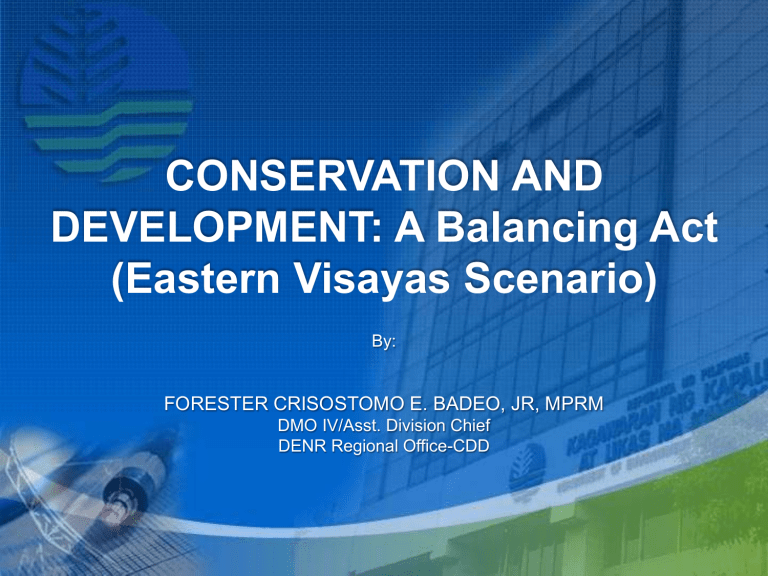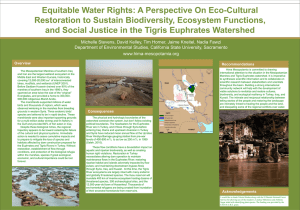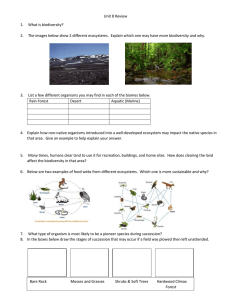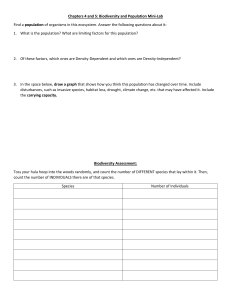
CONSERVATION AND DEVELOPMENT: A Balancing Act (Eastern Visayas Scenario) By: FORESTER CRISOSTOMO E. BADEO, JR, MPRM DMO IV/Asst. Division Chief DENR Regional Office-CDD DENR’s Development Framework DEVELOPMENT GOAL Human well-being, and environmental quality and sustainability ensured ORGANIZATIONAL OUTCOMES Promote human well-being and ensure environmental quality Sustainably-managed environment and natural resources Adaptive capacities of human communities and natural systems ensured DENR FRAMEWORK PLAN Inclusive Growth and Poverty Reduction KEY RESULT AREAS Integrity of the environment and climate change adaptation and mitigation Poverty reduction and empowerment of the poor and vulnerable Transparent, accountable and participatory governance PDP Chapter 9 (Sector Outcome 1) Adaptive capacities of human communities improved PDP Chapter 9 (Sector Outcome 2) Sustainably managed natural resources achieved DENR’S MAJOR PROGRAMS MAJOR FINAL OUTPUTS PDP Chapter 9 (Sector Outcome 3) Environmental quality improved for healthier and cleaner environment Area Management and Convergence Approach • • • • • • Technical Assistance Regulation/permits Funding Enabling policy environment PO/Associati ons Land (tenured; zoned accdng to FLUP) watershed approach Labor • Seedling production • Plantation establishment, maintenance, protection • Harvesting, processing • • Improved Quality of Life and sustainable environment DENR NGAs (Field Offices) LGUs SUCs • • • CSOs Business • • • Supplemental Funding Enabling policy environment • • M&E Community organizing • Capability building (basic bookeeping, inventory, quality control, financial management, organizational development Management of agroenterprise cluster Tech. assistance esp on other livelihood opportunities (agroforestry, processing, quality control, marketing M&E Supplemental Funding Market (branding, quality control, scheduling of production) Managerial expertise ENR Development Principles Good governance Accountability, transparency, participatory Streamlining of permitting system Social justice Equity and gross national happiness Ecosystems integrity Polluters pay • Payment for ecosystems services Rule of law Harmonization with global commitments Key Strategies 1. Adoption of the watershed/river basin framework in planning Prioritizing areas within the watershed Recharge zones for aquifers (sources of water for irrigation, domestic, industrial) High Conservation Value Forests/Protected Area Hazard prone areas (faultlines, landslides, flooding, etc.) Multiple use zone Mountain environmen t Lowland environme nt Sea environme nt Key Strategies Forest Land Use Planning The purpose of FLUP is to build consensus and development recommendations in the best uses of forest lands, including the important step of identifying open access areas and determining appropriate management and best resource managers for these open access areas. The FLUP provides the basis for allocating FFL under appropriate management and tenure arrangement and its consequent assignment to qualified and responsible stewards or managers with established accountabilities Portfolio Planning Approach – pre-identified sites for development by the government in consultation with key stakeholders Key Strategies 2. Adopting soil and water conservation measures 3. Agroforestry systems Agroforestry system Gabion Check dam Key Strategies 4. Closing open access areas of forestlands by granting appropriate tenure/management arrangement Beneficiary Tenurial Instrument Individual Certificate of Stewardship Contract (CSC) Community Community-Based Forest Management Agreement (CBFMA) Special Agreement for Protected Area (SAPA) Integrated Forest Management Agreement (IFMA) Private Business Special Agreement for Protected Area (SAPA) LGU Co-management Key Strategies 5. Area management approach – an integrated area development where all basic societal and economic services are delivered in an area for more impact 6. Promoting social entrepreneurship – packaging development projects with economic empowerment (increasing incomes) of people is a key component Key Strategies 7. Capacity building of DENR frontliners, LGUs, CSO partners, POs and social entrepreneurs 8. Convergence approach among NGAs, LGUs, and CSOs 9. IEC, advocacy and social mobilization 2010 Land Cover viz a viz Conservation & Development Programs/Projects REGION VIII 2010 LAND COVER STATISTICS BY PROVINCE 2010 Land Cover Statistics (NAMRIA) Land Cover Types N. Samar Close Canopy Forest Samar E. Samar N. Leyte So. Leyte 4,825.65 20,754.61 52,272.13 3,325.12 Open Forest 34,149.99 155,384.62 150,410.38 Wooded Grassland 43,879.57 149,273.07 37,263.19 Mangrove 10,758.20 13,677.77 Marshland/Swamps Fishpond Biliran Total % 81,177.51 3.85 26,319.05 8,382.75 374,646.78 17.77 55,701.05 40,228.12 195.153 326,540.15 15.49 7,794.05 8,307.99 597.801 254.894 41,390.70 1.96 11.884 3,836.09 3,847.97 0.18 941.856 1,347.60 5.765 2,167.65 124.259 126.292 4,713.42 0.22 Shrubs 33,109.03 29,027.30 26,186.40 58,389.29 43,142.87 3,277.28 193,132.16 9.16 Grassland 2,500.14 3,727.33 4,610.69 2,476.21 6,423.90 1,991.16 21,729.44 1.03 Open/Barren Lands 212.118 100.505 1,647.34 166.267 23.139 12.142 2,161.51 0.10 Annual Crop 50,591.67 27,806.43 31,123.62 121,504.65 9,967.28 5,441.52 246,435.16 11.69 Perennial Crops 190,979.01 167,120.38 132,042.97 222,326.35 36,680.60 32,123.54 781,272.84 37.05 182.15 0.01 Follow 131.026 51.122 Inland Waters 2,672.45 3,306.64 2,901.53 2,872.44 346.865 120.14 12,220.06 0.58 Built-Up 2,066.18 2,973.31 3,352.62 7,416.94 1,956.05 1,206.82 18,971.92 0.90 558,570.60 418,236.07 537,437.04 169,186.17 Sub-Total Overall Total 371,860.22 2,108,421.77 53,131.68 2,108,421.77 100.00 REGION VIII CONSERVATION & DEVELOPMENT INTERVENTIONS Legal Basis Area 1. Mahagnao Volcano Natural Park (MVNP) PP 1157 635 Has. 2. Lake Danao Natural Park (LDNP) PP 1155 2,193 Has. 3. Samar Island Natural Park (SINP) PP 442 333,300Has. 4. Calbayog Pan-as Hayiban Protected Landscape (CPHPL) PP 1158 7,832 Has. 5. Cuatro Islas Protected Landscape and Seascape (CIPLS) PP 270 12,500 Has. 6. Guiuan Marine Reserve Protected Landscape and Seascape (GMRPLS) PP 469 60,408 Has. 7. Biri-Larosa Protected Landscape and Seascape PP 291 33,492 Has. Name of PA TOTAL 450,360 Has. REGION VIII CONSERVATION & DEVELOPMENT INTERVENTIONS National Greening Program (NGP) Year Area Planted/Developed 2011-2014 62,181.32 Has. 2015 15,694.00 Has. 2016 23,927.98 Has. * 2017 13,270.00 Has. TOTAL 115,073.30 Has. REGION VIII CONSERVATION & DEVELOPMENT INTERVENTIONS Community-Based Forest Management Agreement (CBFMA) Issuance 107 CBFMAs 102,357.549 Has. KBA STATUS IN REGION VIII KBA No. KEY BIODIVERSITY AREA AREA 129 Biri-Larosa Protected Landscape and Seascape 33,492 Has. 130 Samar Island Natural Park 333,300 Has. 131 Andis Island 132 Divinubo Island 133 Matarinao Bay 134 Guian to Salcedo 135 Biliran and Maripipi Island 136 Anonang-Lobi Range 137 Mt. Nacolod 40,860.044 Has. 138 Sugod Bay No Area Estimate 139 Cuatro Islas Protected Landscape and Seascape No Area Estimate No Area Estimate No Area Estimate 60,408 Has. No Area Estimate 47,056 Has. 12,500 Has. REGION VIII CONSERVATION & DEVELOPMENT INTERVENTIONS PROPOSED CRITICAL HABITATS/LCA Name ALNA Critical Habitat Area (hectares) 1129 Location Mount Tres Marias of Barangay Imelda, Naval Visayan Tarictic Hornbill Caojagan Island Critical Habitat 352.57 Catmon Critical Habitat 700 Anonang Lobi Mountain Range 1035.5 Brgy. Caridad,Baybay City,Leyte Visayan hornbill(Penelopide s Panini) Anonang Lobi Mountain Range (Burauen Wildlife Anonang-Lobi Range Critical Habitat) 836.35 Brgy. Dinaayan,Matin-ao,and Malaihao ,Province of Leyte talosi,kalaw,pigeon, tanguile,while lauan,red lauan,apitong) 40,860.044 Mun. Silago, Libagon, St. Bernard, Hinunangan, Sogod, Abuyog & Mahaplag Philippine Eagle Mt. Nacolod Local Conservation Area Island of Caojagan,Pambujan,Norther n Samar Flagship species Brgy. Catmon,Silago,Southern Leyte Giant Flying fox(Pteropus vampyrus) Tarsier(Tarsius syrichta) REGION VIII CONSERVATION & DEVELOPMENT INTERVENTIONS Watershed Characterization/Vulnerability Assessment/Integrated Watershed Management Plan Total Area = 523,298.10 Has. Or 24.82 % Catbalogan Watershed 2,212.54 Has. Basey Watershed 32,621.69 Has. Catarman Watershed 58,101.12 Has. Catubig Watershed 86,298.76 Has. Jicontol Watershed 82,214.56 Has. Maasin Watershed 4,639.93 Has. Buac Watershed 10,333.07 Has. Mainit Watershed 27,309.53 Has. Mangon-Bucan Watershed 6,385.52 Has. Higasaan Watershed 65,538.72 Has. Pagsangahan Watershed 47,264.12 Has Daguitan Watershed 28,952.65 Has. Binahaan Watershed 34,377.58 Has. Bito Watershed 20,945.57 Has. Hinabian Watershed 10,738.94 Has. Anas Watershed 5,363.83 Has. BIODIVERSITY RESOURCES IN REGION 8 based from BRA & FRA Studies BIODIVERSITY RESOURCES IN REGION 8 based from BRA & FRA Studies • Lowland tropical rainforests • Forest over limestone • Old growth • Second growth BIODIVERSITY RESOURCES IN REGION 8 based from BRA & FRA Studies BIODIVERSITY RESOURCES IN REGION 8 based from BRA & FRA Studies BIODIVERSITY RESOURCES IN REGION 8 based from BRA & FRA Studies BIODIVERSITY RESOURCES IN REGION 8 based from BRA & FRA Studies BIODIVERSITY RESOURCES IN REGION 8 based from BRA & FRA Studies Leyte 229 species belonging to 120 genera and 65 families Samar 974 species belonging to 436 genera and 131 families BIODIVERSITY RESOURCES IN REGION 8 based from BRA & FRA Studies BIODIVERSITY RESOURCES IN REGION 8 based from BRA & FRA Studies BIODIVERSITY RESOURCES IN REGION 8 based from BRA & FRA Studies Facts and Figures BIODIVERSITY RESOURCES IN REGION 8 based from BRA & FRA Studies BIODIVERSITY RESOURCES IN REGION 8 based from BRA & FRA Studies BIODIVERSITY RESOURCES IN REGION 8 based from BRA & FRA Studies BIODIVERSITY RESOURCES IN REGION 8 based from BRA & FRA Studies Facts and Figures BIODIVERSITY RESOURCES IN REGION 8 based from BRA & FRA Studies BIODIVERSITY RESOURCES IN REGION 8 based from BRA & FRA Studies BIODIVERSITY RESOURCES IN REGION 8 based from BRA & FRA Studies BIODIVERSITY RESOURCES IN REGION 8 based from BRA & FRA Studies BIODIVERSITY RESOURCES IN REGION 8 based from BRA & FRA Studies Facts and Figures BIODIVERSITY RESOURCES IN REGION 8 based from BRA & FRA Studies BIODIVERSITY RESOURCES IN REGION 8 based from BRA & FRA Studies BIODIVERSITY RESOURCES IN REGION 8 based from BRA & FRA Studies Facts and Figures BIODIVERSITY RESOURCES IN REGION 8 based from BRA & FRA Studies Biodiversity Importance and Relevance Other Ecological Services and Benefits Sustainable Resource Uses and Opportunities Conservation Awareness and Multi- Stakeholder Participation Protected Areas Established and Operationalized Critical Habitat Assessed & Recommended for DAO issuance Watershed Areas Characterized & Conducted Vulnerability Assessment and Management Plan Prepared Forest Land Use Plan Formulated Provided Technical Assistance to LGU’s in the drafting of Integrated Coastal Management Plan Habitat Restoration thru National Greening Program Provided intervention on Key Biodiversity Areas Threatened Biodiversity Deteriorating Ecological Functions and Resource Use Opportunities Natural Hazard-Prone Areas Extractive and Unsustainable Resource Exploitation/Absence and/or Lack of Sustainable Livelihood Options Conversion of Forestlands, Continuing Expansion of Agriculture and Increasing Settlement Areas Boundary Issues and Concerns Low level of Conservation Awareness in the Uplands Issues on Land Tenure and Basic Social Services Untapped Ecotourism Potentials Insufficient Conservation Compatible Livelihood Opportunities Volatile Peace and Order Situation Policy Issues and Concerns ☺ Watershed Characterization & Vulnerability Assessment ☺ Preparation of Integrated Watershed Management Plan ☺ Drafting of Forest Land Use Plan for LGU Adoption ☺ Formulation of Community Resource Management Framework (CRMF) ☺ Re-location and re-measurement of Forest Resource Assessment (FRA) tracks ☺ Forest Products Utilization and Price Monitoring ☺ Formulation of Provincial Foreshore Management and Development Plan (FMDP) ☺ Enhanced National Greening Program Site Assessment = 22,823 Has. Plantation Maintenance & Protection = 63,611 Has. Seedling Production = 6,797,000 Plantation Establishment = 13,270 Has. ☺ Ecotourism Development Land Distribution/Disposition ☺ Management of Protected Areas Ecotourism Development Updating of PA Management Plan Ecotourism Business Plan Promotion of Ecotourism Payment of Ecosystem Services (PES) Study with Resource Valuation Study ☺ Mt. Nacolod Local Conservation Area Creation of LCA Mgt. Committee Forging of Inter-LGU Alliance ☺ Resource Assessment Establishment & Assessment of Permanent Monitoring Plots Socio-Economic Assessment – SRPAO ☺ PA Habitat Protection Program Blue/Green Brigade/PA Patrolling Ecotourism Business Plan Promotion of Ecotourism Payment of Ecosystem Services (PES) Study with Resource Valuation Study ☺ PA Management Preparation/Updating of PA Mgt. Plans PAMB Operations ☺ Biodiversity-Friendly Social Enterprises (BDFE) Development Development of BDFE w/n SINP & CIPLS ☺ Management of Caves and Cave Resources Cave Assessment and Classification ☺ Conservation of Inland Wetlands Profiling of Inland Wetlands (lakes/swamps) Wetland Management Planning ☺ Forest Protection & Law Enforcement ☺ Forest Products Utilization and Land Use Regulation ☺ Enforcement of PA, Wildlife and Cave Laws, Coastal and Marine Rules and Regulations




